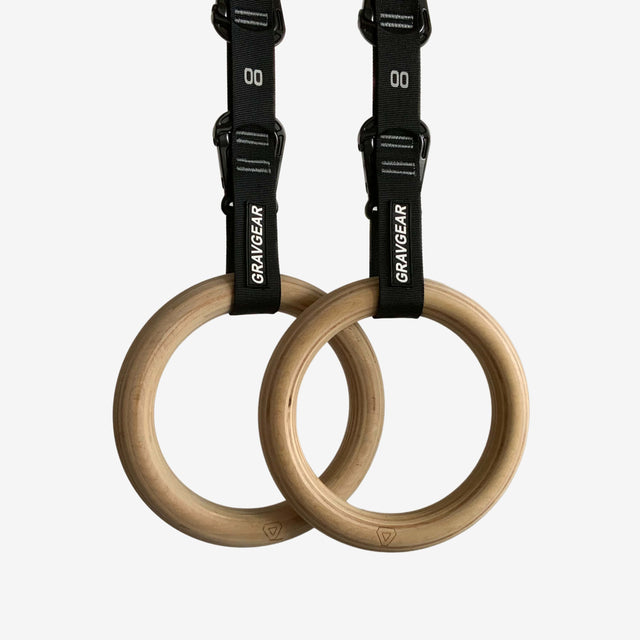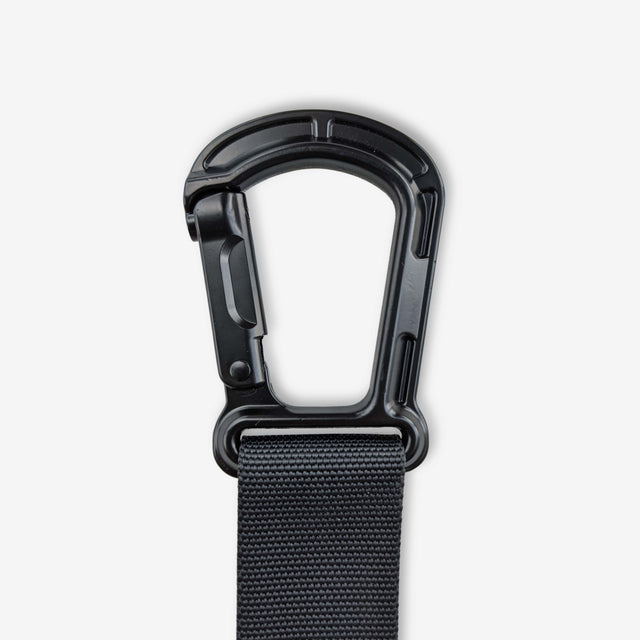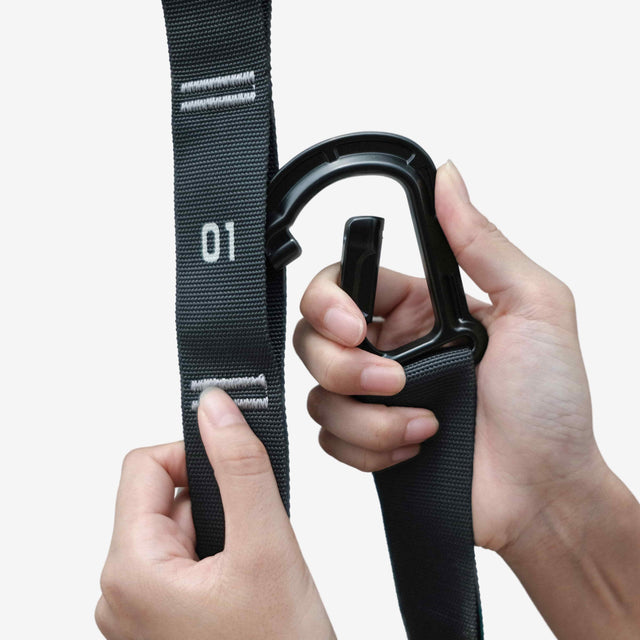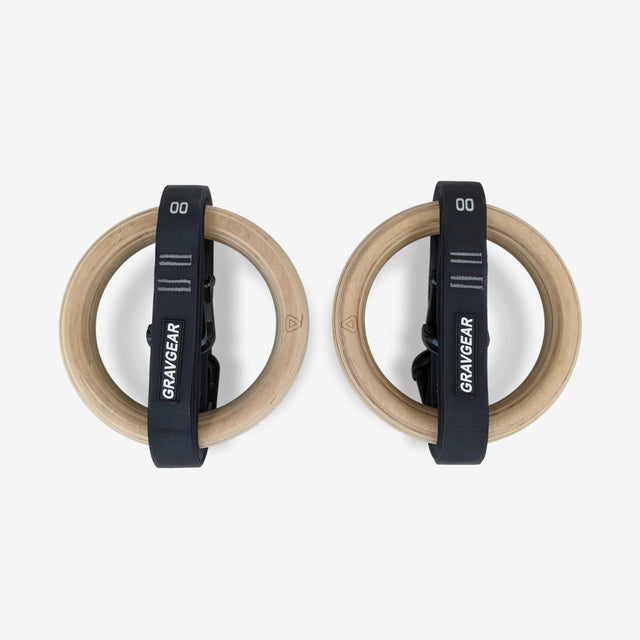HUMBLING Gymnastic Rings Abs Exercises to Feel Like a BEAST (or Beginner)
Gymnastic rings abs exercises target deep core muscles with moves like ring planks, ring knee-to-elbow, ring pikes, single-arm ring planks, ring saws, ring leg raises, ring fall-outs, and hanging L-sits.
Sounds good? Let’s get into:
- So you think your core is strong?
- Why gymnastic rings take core training to a whole new level
- The 8 best gymnastic rings abs exercises
- Sample workout routine for a rock-solid core
- 🖐️5 Common mistakes + form tips
- Real talk🗣️ on the gymnastic rings abs challenge
- Choosing the right gymnastic rings (quick buying guide)
So you think your core is strong?
Think again. The moment you hang onto those gymnastic rings, you’re in for a whole different kind of workout. There’s something about the instability that makes the rings a humbling piece of kit, even for folks who think they’re strong as steel.
Gymnastic rings abs exercises force you to recruit every bit of core strength you’ve got. They call out weak points you didn’t even know you had, and before you know it, you’re wobbling like a beginner again.
But here’s the kicker: it’s a good thing. This kind of training builds strength from the ground up—giving you that iron-clad core and stability that regular ab exercises just can’t touch.
In this guide, we’re diving into ring exercises that target your abs from every angle.
We’ll cover foundational moves (for those who want to start simple) and some high-level techniques for anyone ready to push past their limits.
Whether you’re chasing that six-pack or looking to strengthen your stabilizer muscles, this workout will get you there, one brutal rep at a time.
Why gymnastic rings take core training to a whole new level
If you’re into training abs, gymnastic rings will humble you fast.
There’s no solid ground here—just a couple of rings swinging in mid-air, challenging every stabilizer muscle you didn’t know you had.
Full core activation & real stability
With gymnastic rings, you’re not just working the “mirror” muscles.
Rings demand balance, which pulls in every deep core muscle you’ve got.
No shortcuts here—the instability hits your core from every angle.
Imagine holding a plank, but every second is a battle to keep steady. That’s the kind of activation that builds a core that’s hard as nails.
Connecting every muscle, from shoulders to glutes
This isn’t just about six-pack abs. Every move on gymnastic rings calls on your shoulders, back, and even your glutes to stabilize.
Take a ring rollout, for example. It starts with your core, but you’ll feel it down your entire body.
Strong abs, sure, but you’ll walk away with stronger everything.
Train anywhere
Gymnastic rings are the ultimate travel gym. Small, lightweight, & tough enough to hang from a tree, a beam, or even that rusty garage rafter.
They pack up easy, don’t cost a fortune, and take up zero space. If you’re serious about core training, it’s hard to beat the freedom of taking your workout anywhere.
Yes, they’re safe, if you get quality gear
Now, a word on safety. Quality gymnastic rings are built to hold more than you can throw at them, with bombproof straps that won’t budge.
Get a sturdy set, and you’re set for years of serious training. Anything less? You might just end up with a trip to the ER instead of a six-pack.
The 8 best gymnastic rings abs exercises
Gymnastic rings are a game-changer for core training. Unlike machines, they force your muscles to stabilize and engage fully—giving you a workout that’s intense, effective, and humbling.
Here’s a breakdown of the top 8 moves to make your abs rock-solid…
1️⃣ Ring plank
| Step-by-step instructions | Start by gripping the rings at shoulder width, and extend your legs behind you, forming a straight line from your head to your heels. Engage your core, squeeze your glutes, and don’t let your hips drop. |
| Targeted muscles | Abs, obliques, shoulders, and glutes |
| Progressions/modifications | To start, try a plank with knees bent and slowly work up to straight legs. For more challenge, widen your grip on the rings and feel the core fire up. |
| Pro tip | If you’re quivering like a leaf, you’re doing it right. Rings force your core to stabilize like never before. |
2️⃣ Ring knee to elbow
| Step-by-step instructions | From a plank position, bring your right knee up toward your right elbow, then return to plank. Alternate sides in a slow, controlled motion. |
| Targeted muscles | Obliques, abs, shoulders |
| Progressions/modifications | Beginners can bring knees closer to the chest instead of the elbow. To level up, try adding a twist at the top of each knee lift. |
| Pro tip | Move slow and steady—don’t rush it. Feel each squeeze and contraction as your abs work to stay balanced. |
3️⃣ Ring pike
| Step-by-step instructions | From a plank position, lift your hips up toward the ceiling, bringing your feet in closer to your hands while keeping your legs straight. |
| Targeted muscles | Upper abs, shoulders, lats |
| Progressions/modifications | Beginners can bend their knees slightly as they pike. Advanced? Hold at the top for a couple of seconds. |
| Pro tip | Imagine you’re folding yourself like a closing pocket knife, squeezing the abs as you reach peak height. |
4️⃣ Single-arm ring plank
| Step-by-step instructions | Start in a ring plank but lift one arm off the ring, extending it straight in front of you or out to the side for balance. Hold for a few seconds, then switch arms. |
| Targeted muscles | Abs, obliques, shoulders, glutes |
| Progressions/modifications | Start by shifting weight side-to-side before lifting an arm. As you get stronger, aim for a full 10-second hold. |
| Pro tip | This is a humbling move. Even seasoned athletes will feel the burn as your abs lock in to keep you steady. |
5️⃣ Ring saws
| Step-by-step instructions | Begin in a plank position on the rings. Gently rock your body forward and backward by moving from your shoulders. Control the motion with your core. |
| Targeted muscles | Abs, shoulders, upper back |
| Progressions/modifications | Start by shifting your weight just a few inches forward and back. As you progress, extend the range to maximize the challenge. |
| Pro tip | It may look like a small movement, but the intensity? Big. Keep your abs tight, and don’t let your lower back arch. |
6️⃣ Ring leg raises
| Step-by-step instructions | Hang from the rings with your arms fully extended, then raise your legs up to form a 90-degree angle with your torso. Lower back down in a controlled movement. |
| Targeted muscles | Lower abs, hip flexors, shoulders |
| Progressions/modifications | Start by raising your knees instead of straight legs. For more intensity, aim to lift until your toes are at eye level. |
| Pro tip | Think of lifting your legs, not swinging. A slow descent back to the starting position makes it twice as effective. |
7️⃣ Ring fall-outs
| Step-by-step instructions | Kneel on the ground with your hands in the rings at shoulder level. Extend your arms forward, rolling out as far as you can while keeping your core tight, then return to starting position. |
| Targeted muscles | Abs, shoulders, lats |
| Progressions/modifications | Start with a limited range of motion until you feel comfortable rolling out further. |
| Pro tip | The further you roll out, the more intense the burn. Picture it as an ab wheel rollout, but with the instability of rings added in. |
8️⃣ Hanging L-sit
| Step-by-step instructions | Hang from the rings, and lift your legs straight out in front of you, aiming for a 90-degree angle at the hips. Hold as long as you can. |
| Targeted muscles | Abs, hip flexors, shoulders, lats |
| Progressions/modifications | Beginners can start with one knee bent. If you’re ready to challenge yourself, go for the V-sit, lifting legs even higher. |
| Pro tip | This isn’t about swinging or kicking up—go slow and focus on holding that L-shape. It’s humbling and tough but worth every second. |
Sample workout routine for a rock-solid core
Building core strength with gymnastic rings is about consistency, progression, and keeping that core tight.
This routine will take you through the best progression, whether you’re starting out or pushing your limits.
Each exercise is planned with reps, tempo, and rest time, so you’re not left wondering how to get the most out of each set.
Warm-up (5 minutes)
Always start with a dynamic warm-up. A few minutes of planks, bodyweight squats, and arm swings will prepare your body for the intensity of ring work.
For beginners, it’s crucial to feel your core bracing from the start.
Core workout routine
| Exercise | Beginner | Intermediate | Advanced |
| Ring plank | 3 sets, 40s hold, 60s rest | 4 sets, 50s hold, 50s rest | 5 sets, 60s hold, 40s rest |
| Ring knee to elbow | 3 sets, 8 reps, 4-1-2-0 tempo, 60s rest | 4 sets, 10 reps, 4-1-2-0 tempo, 50s rest | 5 sets, 12 reps, 4-1-2-0 tempo, 40s rest |
| Ring pike | 3 sets, 8 reps, 4-1-2-0 tempo, 60s rest | 4 sets, 10 reps, 4-1-2-0 tempo, 50s rest | 5 sets, 12 reps, 4-1-2-0 tempo, 40s rest |
| Ring saws | 3 sets, 8 reps, 4-1-2-0 tempo, 60s rest | 4 sets, 10 reps, 4-1-2-0 tempo, 50s rest | 5 sets, 12 reps, 4-1-2-0 tempo, 40s rest |
| Single-arm ring plank | 3 sets, 40s hold, 60s rest | 4 sets, 50s hold, 50s rest | 5 sets, 60s hold, 40s rest |
| Ring leg raises | 3 sets, 8 reps, 4-1-2-0 tempo, 60s rest | 4 sets, 10 reps, 4-1-2-0 tempo, 50s rest | 5 sets, 12 reps, 4-1-2-0 tempo, 40s rest |
| Ring fall-outs | 3 sets, 8 reps, 4-1-2-0 tempo, 60s rest | 4 sets, 10 reps, 4-1-2-0 tempo, 50s rest | 5 sets, 12 reps, 4-1-2-0 tempo, 40s rest |
| Hanging L-sit | 3 sets, 40s hold, 60s rest | 4 sets, 50s hold, 50s rest | 5 sets, 60s hold, 40s rest |
Tempo guide
4-1-2-0: Lower for 4 seconds, pause for 1 second, lift for 2 seconds, no rest between reps.
Frequency
For the best gains, hit these core exercises twice a week on your non-consecutive core days, like Tuesday and Thursday.
For a balanced week, add two ab-focused exercises after each major push, pull, or leg workout to keep your core constantly working.
This keeps the recovery solid for every muscle group while building habit and consistency in your training routine.
Additional tips
Focus on control
For each movement, especially with rings, control is king. Keep every rep tight.
Adapt as you progress
If you’re hitting 12 reps easily, it’s time to step up to the next level or add some weight with a vest.
Stay consistent
Showing up to train is half the battle. Set a regular schedule and stick with it.
🖐️5 Common mistakes + form tips
1. Engage like you’re bracing for a punch
One of the most common slip-ups with gymnastic ring exercises is letting the hips sag, especially in planks and other core-heavy moves.
It’s easy to think you’re “holding tight,” but if you’re not actively pulling your belly button towards your spine, you’re probably leaving some core activation on the table.
| Quick tip |
| Engage the core as if bracing for a punch—squeeze everything from the glutes to the abs. Think of creating a straight line from head to toe. |
2. Don’t let your lower back take the hit
Without proper form, these exercises can throw a surprising load on the lower back.
If you’re feeling strain there, it’s a sure sign your core isn’t carrying its share of the weight.
Most people experience this in exercises like the ring fall-out and knee-to-elbow.
| Quick tip |
| Pull in your lower ribs to avoid “flaring” and keep everything tight. If it’s still tough, adjust your angle—go a bit easier until you can keep the lower back solid. |
3. Rings not stable?
If you’re wobbling all over the place, chances are your shoulders aren’t “set.”
Every ring exercise benefits from stabilizing the shoulder blades, keeping them pulled back and down, almost as if you’re squeezing a pencil between them.
| Quick tip |
| Keep those shoulders in line and actively squeeze. Stability is a major part of core strength on the rings. |
4. Feeling it in your wrists?
When starting with gymnastic rings, it’s easy to overlook wrist positioning. A loose or twisted grip can lead to strain fast.
In exercises like ring planks, a neutral wrist (not bending backward) is key to long-term comfort and strength.
| Quick tip |
| Keep the wrists straight, especially during holds. Adjust your hand position if necessary to reduce pressure. |
5. Breathe… or risk gassing out…
Holding your breath might feel like a quick fix to tension, but it’s a dead-end road for your strength.
Not breathing properly leads to early fatigue and can mess with your form in seconds.
For each movement, maintain steady, even breathing to fuel those muscles.
| Quick tip |
| Inhale to prepare, exhale as you exert force. Keep it slow and steady. |
Real talk🗣️ on the gymnastic rings abs challenge
Let’s be blunt—training on rings isn’t just humbling; it’s like putting your strength under a microscope.
Every minor weakness, every overlooked muscle—it all gets exposed.
You think your core is rock-solid? Rings will test that claim fast.
But that’s exactly why they’re worth the grit!
Weaknesses front & center
Rings reveal weaknesses like no other equipment. The instability means you can’t get away with cheating or compensating.
The core’s working overtime, sure, but so are the shoulders, back, and every stabilizer muscle you’ve got. It’s a total body challenge that refuses shortcuts.
Stability from core to shoulders
As you build strength on rings, there’s more than just an ab workout going on. You’re actually fortifying your shoulders, back, and joints.
Every core move on the rings recruits stabilizers you probably didn’t know you had.
The result? Your entire upper body starts feeling more solid, more resilient.
Why rings build resilience
Training on rings isn’t just physical. It’s a mental game too.
Every rep demands focus, every set requires balance, and honestly, every session is a reminder of how tough this gear can be.
But with each hold and controlled movement, you’re not just training muscles—you’re training resilience.
You’re building the kind of mental toughness that carries over to any fitness goal.
| Real talk takeaway |
| Rings demand commitment. You’ll have good days and rough ones. But each time, you’re stronger for it. And if you can handle the rings, the rest of your training is a walk in the park. There will be no setbacks as your strength is there to stay at each checkpoint towards your strength goals. |
Choosing the right gymnastic rings (quick buying guide)
When it comes to picking gymnastic rings, not all are built the same. The material alone can make a big difference in feel, durability, and overall experience.
Here’s what you need to know to make the right choice…
Wood vs. plastic rings
Both wood and plastic rings have their pros and cons, and the right pick depends on what you’re looking to get out of your training.
| Material | Pros | Cons |
| Wood | Natural feel, excellent grip, soft on the hands | Can wear down over time, not ideal for outdoor use (exposure to wet weather can damage) |
| Plastic | Durable, suitable for indoor & outdoor use, typically more affordable | Can be rough on the hands over time, grip can get slippery without chalk |
Wood rings offer a smoother, natural feel that’s easy on the hands and great for grip, but they’re best kept indoors to avoid wear and splintering.
On the other hand, plastic rings are built to last and can take a bit of a beating outdoors, but they can feel a bit harsher on the hands, especially after extended use.
Marked straps are a no-brainer for setup
If you’re new to rings or just want to save yourself some hassle, opt for marked straps.
These have lines or numbers on them, making it easy to adjust both rings to the same height.
It’s a simple feature, but one that can save you a lot of time and keep your setup frustration-free.
Quick buying tip
Stick to trusted brands that emphasize build quality, especially for the straps and buckles—these are what keep you hanging safely. If you’re ready to get started, go for rings with solid user reviews and, ideally, a weight rating well above what you’ll be putting on them.
If in doubt, remember: the rings are holding you up—don’t cut corners on quality. Go for high-rated, durable rings from reliable sellers, especially if you’re using them daily.
If you found this helpful…
Gymnastic rings abs training isn’t easy, but if you’re ready to take it on, you’re not alone.
We’d love to hear about your experiences, tips, and even the humbling moments when the rings reminded you who’s boss.
Drop a comment below with your feedback or any extra insights you’ve picked up along the way.
Feeling motivated to keep going? Join us on the Gravgear Telegram channel for real-time progress updates, training advice, and a community of people just as hooked on this journey as you are.
It’s not all serious either—plenty of banter, shared wins, and maybe a few “what was I thinking?” moments. Along with cool yellow dude telegram stickers to post to your friends…
And hey, don’t go it alone. Send this post to your mates or gym buddies who could use a new challenge.
Take on the rings together, share progress, and keep each other accountable.










0 Comments
There are no comments for this article. Be the first one to leave a message!